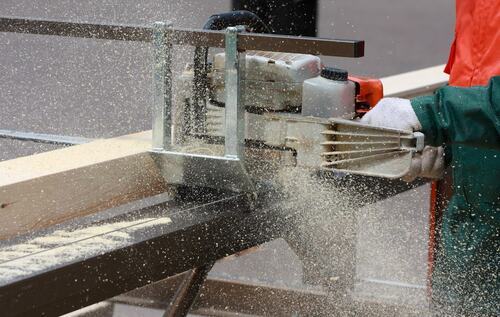Portable Sawmill Basics: A Beginner’s Guide
Introduction
If you love all things wood and woodworking, a
portable sawmill
gives you complete control over the very first step of a project. Wouldn’t you want to choose exactly how your boards are milled—and at a steep discount from what you’d pay at a lumber or hardwood retailer?
Purchasing a portable sawmill provides new opportunities if you work with wood. DIY lumber milling frees you from the restrictions of traditional lumber yards, where only specific boards are available and often at fairly high prices. Instead, you can source and cut your own logs.
Operating a mobile sawmill is also very accessible for woodworkers, small-scale lumber producers, and DIYers who have forested land. These sawmills are affordable to purchase, designed for one person to run, and fairly easy to maintain. Here’s a rundown of the portable sawmill basics you should know before getting one.
- Portable Sawmills
- Benefits
- Components
- Workings
- Factors
- Beginning
- Maintaining
- Challenges
What is a Portable Sawmill?

A Portable Chainsaw Mill in Action
A portable sawmill is used to mill logs into boards and is a model that can be moved between locations.
Most models have a bed that holds the log, a blade that cuts the log, and rails along which the blade can travel the length of the log. Higher-end models might have additional features, but most portable sawmills are largely manually run. They’re designed so that a single person can operate them.
Kinds of Portable Sawmills
The most important feature of a portable sawmill is its blade. There are three different types of blades that these mills can have:
Portable Bandsaw Mills
Portable bandsaw mills use an oversized bandsaw blade , which is a continuous strip of steel that has teeth on one side. Because the blade is comparatively thin, these mills reduce sawdust waste and maximize board feet yield.
This is the most common type of mobile sawmill. Look at bandsaw mill options no matter what your reasons for getting a sawmill are.
Chainsaw Mill
Chainsaw sawmills use an oversized chainsaw blade, where interlinked teeth make larger cuts. The most basic chainsaw mill models provide a guide along which a separate chainsaw can be run.
This is the most affordable type of sawmill, but the fairly wide teeth produce much more sawdust and have a much lower yield.
Consider starting out with one of these if you’re on a budget, and then you can upgrade to a bandsaw mill in the future. Sometimes, a chainsaw milling guide and separate chainsaw is the only type of portable mill that can be carried to especially remote locations, such as an off-grid cabin, for example. Keep in mind that anything requiring a separate chainsaw will be limited by the size of your chainsaw.
Circular Sawmills
Circular saws use a circular blade akin to an oversized table saw blade. These are the fastest sawmills, and their waste and yield are on par with bandsaws .
The speed of circular sawmills is important in more commercial situations, and you’ll find many circular sawmills at larger lumber mills (along with bandsaw sawmills). That speed is usually less important when operating a portable sawmill, though.
Don’t be afraid to get a circular sawmill if you come across a good option. You’ll likely find that a bandsaw mill meets your production needs and is easier to use, however.
Benefits of Using a Portable Sawmill

A Portable Sawmill Being Used Next to a River
Whether you’re a woodworker, forested land owner, or want to start a small-scale logging business, there are multiple reasons to get a portable sawmill.
Cost-Effectiveness
By milling your own lumber , you can significantly reduce or even eliminate the expense of purchasing lumber from suppliers. Many owners sell boards, which can provide a positive return on investment on a portable sawmill.
Versatility
A portable sawmill allows you to process logs according to your needs. You can make boards in any thickness that you need and in any width up to the sawmill’s capacity. Being able to move the sawmill also lets you mill logs on your property or at other locations.
Sustainability
A portable sawmill lets you use locally sourced wood, often from your own land. Processing trees that already fell or must be cut for safety reasons is more environmentally friendly than harvesting trees commercially. There’s also a carbon emissions reduction since logs don’t need to be transported far (if at all).
Custom Cutting Capabilities
You have complete control over the way logs are cut. Not only can you cut boards to whatever thickness and width you need (within a mill’s capacity), but you also can plan cuts around a board’s grain pattern.
Key Components of a Portable Sawmill
A portable sawmill is a fairly basic piece of equipment. There are four main components:
- Saw Head: This houses the blade (bandsaw, chainsaw, or circular saw) and is the most important part of the sawmill.
- Bed or Track System: The bed or track system provides support for the log and guides the saw head for accurate cuts. The user usually pulls the saw head along the track.
- Power Source: Saw heads can be powered by gas, diesel, or electricity. They’re often run off of fuel tanks, generators, hardwired outlets, or high-capacity batteries.
- Control Panel: This allows you to adjust blade height, feed rate, and other cutting parameters.
How Portable Sawmills Work
Running a portable sawmill requires setting the log on the mill, setting the cut depth, and making the cuts. The process is as follows:
- Log Placement: Secure the log onto the mill bed.
- Setting the Cut: Adjust the saw head to the desired height for the first cut.
- Milling the Log: Engage the blade and push the saw head along the length of the log.
- Repositioning: Adjust the saw head and log for subsequent cuts as needed.
For solo operators, the biggest challenge is often positioning the log. Machinery like a tractor, skid steer, or mini excavator can be used. Some operators devise manual log-handling techniques using levers to move logs. Higher-end portable mills have hydraulic systems that make placement and repositioning much easier.
Choosing the Right Portable Sawmill

An Arborist Now Milling Specialist Using a Portable Sawmill
Portable sawmilling equipment varies a lot in size, features, and cost. Make sure you consider these factors when choosing a mill:
- Log Size Capacity: The sawmill needs to have a capacity that’s sufficient for the largest logs you anticipate milling.
- Power Source: The power source needs to be practical for you to use, especially if processing wood in multiple or hard-to-reach locations.
- Portability: Just how portable the sawmill will be depends on how much you’ll be moving it and where you’ll be moving it. Many are trailerable.
- Budget: You should be able to find a sawmill solution that fits within your budget. You can upgrade later on if on a tight budget right now.
Manual vs. Hydraulic
Manual mills are more affordable but require physical effort to operate. Hydraulic mills have systems that help with handling logs. Which one you should get depends on your physical abilities, other available equipment, and what size logs you plan to mill.
Getting Started with Your Portable Sawmill
When starting out with your first portable sawmill, make sure you’re set up for success. You’ll need to pay attention to:
- Site Preparation: Choose a level, stable area that has enough space for the logs you’ll mill.
- Safety : Always wear appropriate safety gear, including goggles, gloves, and hearing protection. Use the manufacturer’s instructions to familiarize yourself with all operational controls and emergency stops.
- Basic Operation Tips: Start with smaller, easier-to-handle logs to become comfortable with portable sawmill operation before progressing to larger ones.
Maintenance and Care
Most portable sawmill owners maintain their mills themselves. This typically requires:
- Regular Cleaning: Remove sawdust and debris after every use to prevent buildup and ensure smooth operation.
- Blade Maintenance: Keep your blades sharp and pay attention to sawmill blade tensioning for optimal cutting performance.
- Lubrication: Regularly lubricate moving parts according to the manufacturer’s recommendations.
Common Challenges and Solutions
While sawmilling is very doable, you’ll undoubtedly face some challenges. Here are some tips to help:
- Irregular Logs: Use shims or wedges to level irregular logs on the bed for straighter cuts.
- Achieving Straight Cuts: Ensure your mill’s track is level and the blade is properly tensioned.
- Managing Sawdust: Collect and dispose of sawdust regularly so it doesn’t pile up too much.
Mill Your Wood with a Portable Sawmill

Freshly Milled Wood is Examined On-site by an Arborist Now Expert
Portable sawmilling is something anyone who’s familiar with wood and willing to work can get into. Learn more about these sawmills, and you soon could be enjoying the satisfaction of processing your own trees into boards that’ll work well for your projects.
Review what your milling needs and goals are, and then choose a bandsaw, chainsaw or circular saw mill that’ll cut the logs you have. You can quickly learn the components of a portable sawmill and how they work and soon get started milling your own or others’ logs. It’s something that anyone who’s familiar with wood processing and willing to work a bit can do.
For more information about the process of milling wood, speak with one of our team members who works the sawmill. We’re regularly milling logs from around the Bay Area and happy to mill yours or help you learn how to mill them yourself.
FAQ
How much does it cost to purchase a portable sawmill?
Portable sawmills vary in cost, but tend to be quite affordable. Lower-priced options are available new for a few thousand dollars. More high-end ones might be $10,000 to $20,000.
What types of wood can you mill with a portable sawmill?
Portable sawmills are able to mill any type of domestic wood, hard or soft. Most owners focus on hardwoods.
Can you use boards immediately after milling?
Boards should be dried after milling, as they’ll shrink and warp if not dried properly. Air drying and kiln drying are the two methods.


